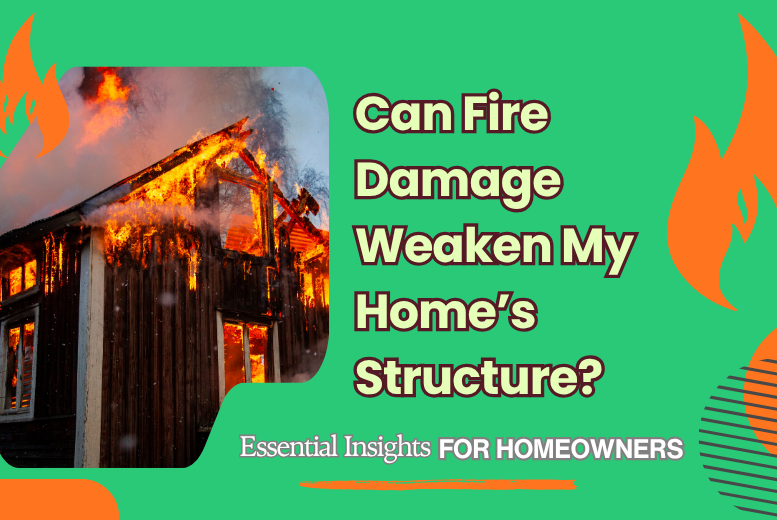Fire can be one of the most devastating forces that threaten the safety and integrity of your home. Beyond the immediate destruction of flames and smoke, many homeowners grapple with a lingering concern: can fire damage weaken my home’s structure? This question is crucial for anyone wanting to protect their investment and ensure the safety of their loved ones. Even minor fire incidents can compromise essential elements like beams, walls, and foundations, often leaving unseen damage that may arise long after the flames are extinguished. In this article, we will explore the intricate relationship between fire damage and structural integrity, providing essential insights that every homeowner should be aware of. Understand how to identify potential risks and the steps you can take to safeguard your home against future threats. Stay informed and empowered to make the best decisions for your home.
Understanding the Impact of Fire Damage on Structural Integrity
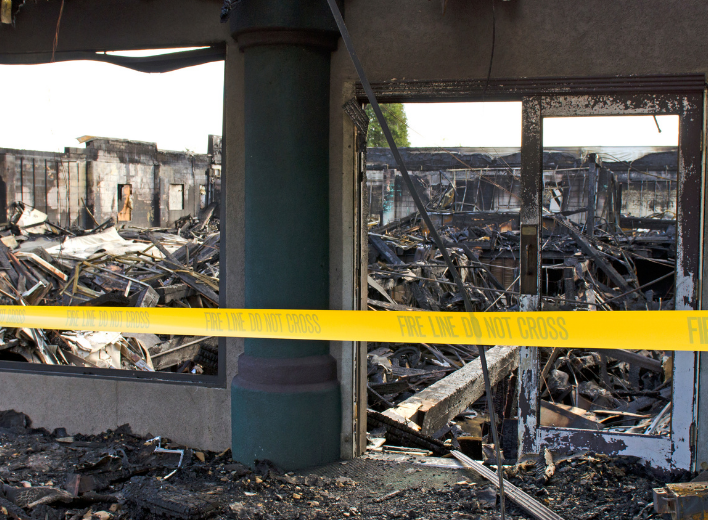
When a fire damages a home, its effects often extend far beyond visible surface destruction. The heat, smoke, and water used during firefighting can compromise the building’s strength and safety. For a full guide on recovering from smoke exposure, see the warning signs of smoke damage to identify early indicators before structural problems develop. Understanding these risks is vital for homeowners seeking restoration and protection.
Heat Damage to Core Structural Components
Extreme temperatures during a fire can weaken beams, columns, and walls. Wood may char and lose strength, while steel can bend and deform under pressure. This hidden damage poses serious risks to stability if not addressed promptly.
Water Damage from Firefighting Efforts
While essential for extinguishing flames, water can saturate building materials, leading to warping, swelling, or cracks. Over time, trapped moisture weakens foundations and encourages mold growth, creating additional risks beyond the initial fire damage.
Long-Term Risks of Hidden Structural Weakness
Not all structural damage is immediately visible after a fire. Cracks, shifts, or weakened supports may develop over weeks or months, endangering the home’s safety. Professional inspections are critical for detecting and resolving these hidden risks early.
Types of Fire Damage: Structural vs. Non-Structural
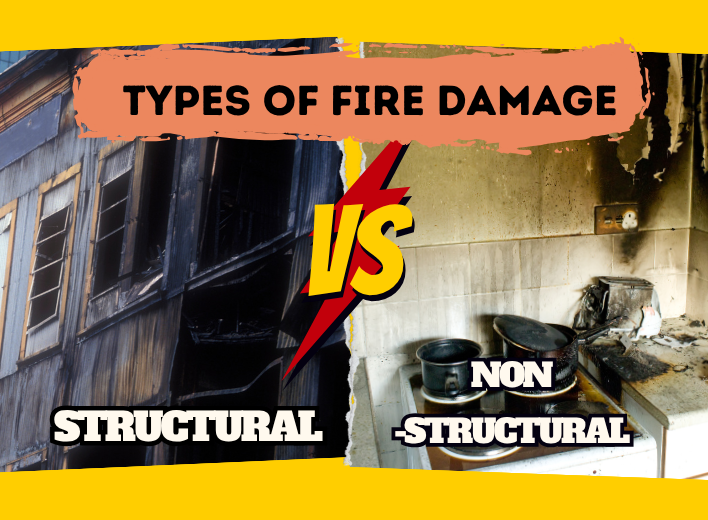
When a fire impacts a property, the damage is often more complex than what is immediately visible. Fire can compromise both structural and non-structural elements, each presenting unique risks and challenges that require careful evaluation and professional restoration.
1. Structural Damage to Foundations and Framework
Structural damage occurs when the fire weakens load-bearing components such as beams, columns, walls, or the foundation. These elements are essential for stability, and once compromised, they can put the entire building at risk of collapse.
2. Non-Structural Damage to Interior Spaces
Non-structural damage typically affects areas like drywall, flooring, ceilings, and fixtures. While these elements don’t support the building’s weight, their destruction can still make spaces uninhabitable and require extensive replacement to restore the home’s functionality. Learn more about recovery techniques in restore your home after fire damage for effective rebuilding after structural and surface-level losses.
3. Smoke and Soot Damage Across All Surfaces
Even beyond flames, smoke and soot can penetrate deep into surfaces, leaving behind stains and odors. These residues can corrode materials over time, impact indoor air quality, and make cleaning far more challenging without professional equipment.
4. Water and Chemical Damage from Firefighting Efforts
Fire suppression efforts often cause secondary damage. Water can saturate walls and floors, while fire retardants and chemicals may leave residues that damage materials. Addressing these effects is critical to prevent mold growth and long-term structural deterioration.
Common Signs of Structural Weakness After a House Fire
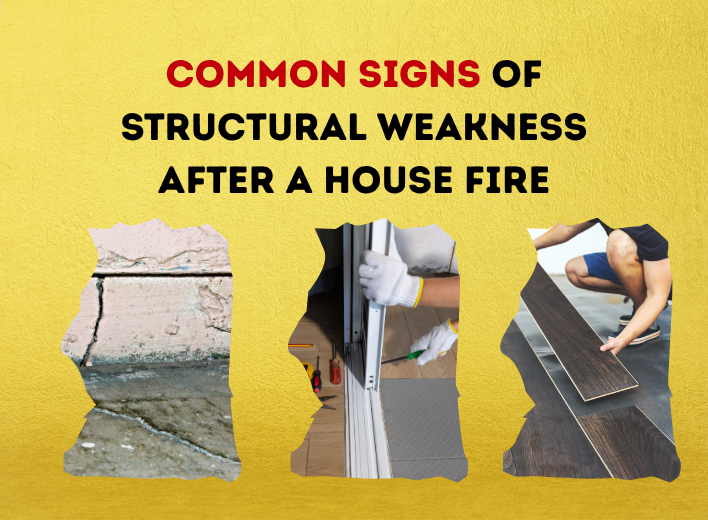
After a house fire, hidden structural issues may compromise your home’s safety even if the damage isn’t immediately visible. Recognizing early warning signs of weakness is crucial to prevent further deterioration and to protect both your property and family.
1. Cracks in Walls and Foundations
One of the most telling signs of fire-related structural damage is cracks in walls or foundations. These may begin as hairline fractures but expand over time, signaling that the building’s core support system has been weakened.
2. Misaligned Doors and Windows
If doors and windows no longer close smoothly, it could mean the frame of your home has shifted or warped from heat exposure. This misalignment may appear minor but often indicates deeper structural instability requiring professional evaluation.
3. Sagging or Uneven Floors
Floors that sag or feel uneven can point to compromised beams or joists. Heat and water damage can reduce their load-bearing strength, making the surface unsafe and increasing the risk of collapse if left unaddressed.
4. Warped or Bowing Walls
Walls that appear bowed, bulging, or warped are another red flag after a fire. These deformations suggest that the material has lost integrity under intense heat or water, putting both structural balance and safety at risk.
Hidden Fire Damage: Why Professional Inspections Are Critical in Virginia Homes
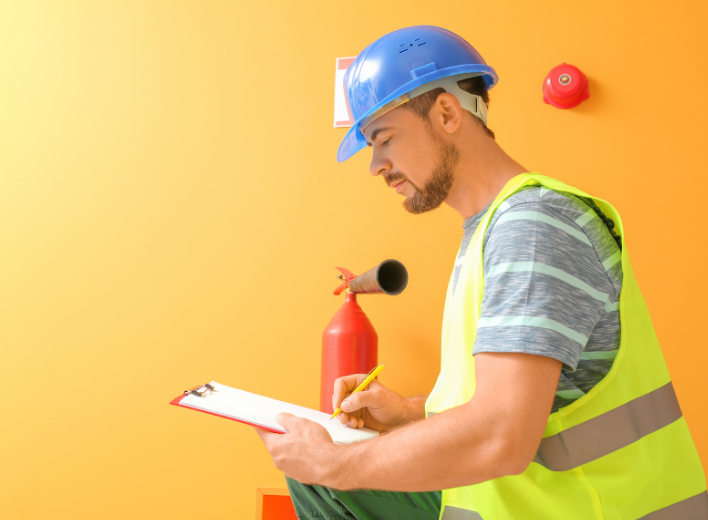
Hidden fire damage can be just as dangerous as visible damage, if not more so. This type of damage is often not immediately apparent and can go unnoticed for months or even years. Professional inspections are critical for uncovering hidden issues and ensuring the safety of the home.
One of the main reasons hidden fire damage is so dangerous is that it can weaken the structure of the home without any obvious signs. For example, wooden beams that have been charred on the inside may still appear intact on the surface. However, their load-bearing capacity can be significantly reduced, making them prone to failure.
Professional inspectors have the tools and expertise to identify hidden fire damage that may not be visible to the untrained eye. They can use specialized equipment, such as thermal imaging cameras and moisture meters, to detect heat and water damage within walls, floors, and ceilings. This thorough inspection process can help uncover potential issues before they become major problems. For expert evaluation tips, explore finding a certified restoration contractor to ensure your home receives professional-grade assessment and repair.
In Virginia, where homes are often exposed to a range of weather conditions, it is especially important to have a professional inspection after any fire incident. The combination of heat, humidity, and seasonal changes can exacerbate hidden damage, leading to further deterioration over time. By investing in a professional inspection, homeowners can protect their property and ensure the long-term safety of their home.
Can Fire Damage Weaken My Home’s Structure Beyond Repair? Expert Opinions
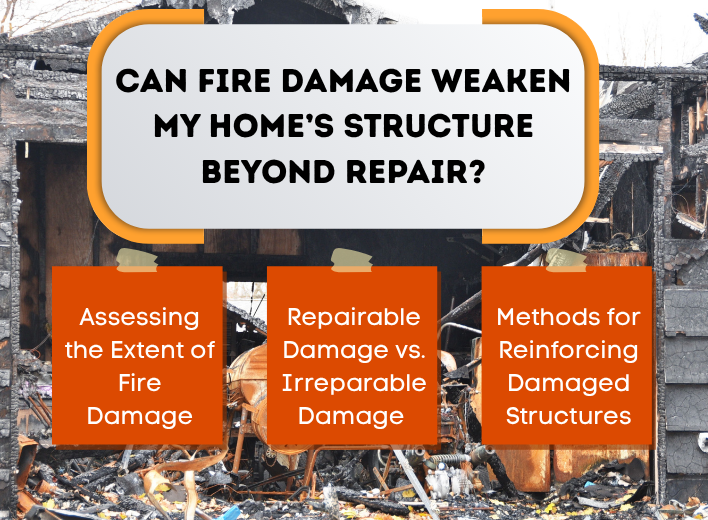
Determining whether fire damage can compromise a home beyond repair requires careful assessment. Experts note that the severity, location, and materials affected all play a role. For a full understanding of costs and timelines, check out the true cost of flood restoration in VA to compare restoration scope and investment levels. Early evaluation by professionals is critical to ensure safety and informed decisions.
Assessing the Extent of Fire Damage
The first step is a comprehensive inspection of the property. Structural engineers examine load-bearing elements such as beams, columns, and foundations to determine whether the damage is superficial or threatens the overall stability of the home.
Repairable Damage vs. Irreparable Damage
Not all fire damage is catastrophic. Experts emphasize that minor charring or localized weakening can often be repaired through reinforcement, material replacement, and structural restoration, restoring stability and extending the life of the home.
Methods for Reinforcing Damaged Structures
When repair is feasible, specialists employ techniques like replacing compromised beams, strengthening columns, and using high-grade materials to restore integrity. Proper execution by trained professionals is essential to ensure that repairs are both safe and durable.
Local Fire Damage Restoration in Virginia: Protecting Your Property’s Strength
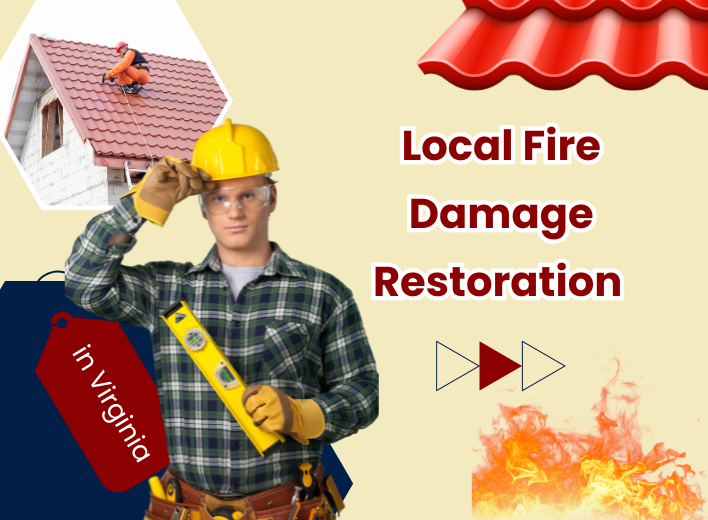
In Virginia, fire damage can compromise both the safety and structural integrity of a home. That’s why local fire damage restoration services are essential for homeowners looking to restore their property efficiently and effectively. These professionals bring the expertise, tools, and experience necessary to assess fire damage, perform repairs, and ensure that homes are safe, secure, and structurally sound.
One of the main advantages of working with local restoration specialists is their in-depth understanding of the unique challenges facing homes in Virginia. They are familiar with local building codes, typical construction materials, and regional weather patterns that can affect restoration efforts. This local knowledge allows them to tailor solutions specifically for each property, addressing damage comprehensively and minimizing long-term risks.
Fire damage restoration generally follows a multi-step process: initial assessment, debris removal, structural repairs, and final cleaning and decontamination. Local restoration companies in Virginia can manage all these stages, coordinating repairs seamlessly and reducing the disruption to homeowners’ daily lives.
For homeowners in Lorton, VA, partnering with a trusted local company like Flood Expert ensures your property is in capable hands. Our team specializes in fire damage restoration in Tysons Corner and Lorton, prioritizing safety, quality, and efficiency at every step. If your home has experienced fire damage, contact Flood Expert in Lorton, VA today to schedule a professional assessment and start restoring your property’s strength and value with confidence.
Preventing Long-Term Structural Problems After Fire Damage
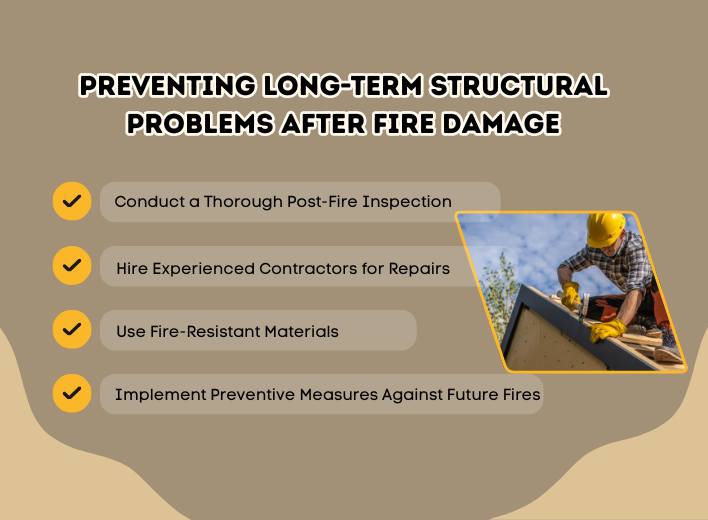
Addressing fire damage promptly is crucial to prevent long-term structural issues. By taking proactive measures and engaging qualified professionals, homeowners can safeguard their property’s stability, mitigate hidden risks, and ensure lasting safety for their home.
Conduct a Thorough Post-Fire Inspection
A comprehensive inspection identifies visible and hidden damage to beams, walls, and foundations. Certified professionals can pinpoint areas of concern early, allowing timely repairs that prevent deterioration and long-term structural compromise.
Hire Experienced Contractors for Repairs
Engaging reputable contractors ensures repairs are executed with quality materials and industry standards. Proper restoration strengthens compromised structures, preventing future problems and maintaining the home’s integrity over time.
Use Fire-Resistant Materials
Incorporating fire-resistant materials in reconstruction, such as treated wood, metal, and non-combustible insulation, reduces the risk of repeated damage and enhances the overall resilience of the property.
Implement Preventive Measures Against Future Fires
Homeowners should install smoke detectors, fire extinguishers, and maintain electrical systems and chimneys. Regular upkeep minimizes fire risks, protecting the home and preventing structural issues from recurring.
Conclusion: Ensuring Your Home’s Safety After a Fire
Ensuring the safety of your home after a fire is a multifaceted process that requires careful attention and professional expertise. From understanding the impact of fire damage on structural integrity to recognizing the signs of potential weaknesses, homeowners must be proactive in addressing any issues that arise.
Professional inspections and timely repairs are essential for uncovering hidden damage and restoring the structural stability of the home. By working with local fire damage restoration services in Virginia, homeowners can benefit from tailored solutions that address the unique challenges associated with their property.
Preventing long-term structural problems involves taking proactive measures, such as conducting regular maintenance, using high-quality materials, and implementing fire safety practices. By staying informed and vigilant, homeowners can protect their investment and ensure the ongoing safety and well-being of their loved ones.
In conclusion, while fire damage can pose significant risks to a home’s structure, understanding these risks and taking the appropriate steps can help to mitigate them. By being informed and seeking professional assistance when needed, homeowners can navigate the challenges of fire damage and maintain a safe and secure home for years to come.

